B
Critical Exam Information
Exam candidates want to pass their PMP exam on the first attempt. Why bother sitting for an exam if you know you’re not prepared? In this appendix, you’ll find the details that you must know to pass the exam. These facts won’t be everything you need to know to pass the PMP exam—but you can bet you won’t pass the exam if you do not know the critical information in this appendix.
Exam Test-Passing Tips
For starters, don’t think of this process as preparing to take an exam, but think of it as “preparing to pass an exam.” Anyone can prepare to take an exam: just show up. Preparing to pass the PMP exam requires project management experience, diligence, and a commitment to study.
Days Before the Exam
In the days leading up to your scheduled exam, here are some basics you should do to prepare yourself for success:
![]() Get some moderate exercise Find time to go for a jog, lift weights, take a swim, or do whatever workout routine works best for you.
Get some moderate exercise Find time to go for a jog, lift weights, take a swim, or do whatever workout routine works best for you.
![]() Eat smart and healthy If you eat healthy food, you’ll feel good—and feel better about yourself. Be certain to drink plenty of water, and don’t overdo the caffeine.
Eat smart and healthy If you eat healthy food, you’ll feel good—and feel better about yourself. Be certain to drink plenty of water, and don’t overdo the caffeine.
![]() Get your sleep A well-rested brain is a sharp brain. You don’t want to sit for your exam feeling tired, sluggish, and worn-out.
Get your sleep A well-rested brain is a sharp brain. You don’t want to sit for your exam feeling tired, sluggish, and worn-out.
![]() Time your study sessions Don’t overdo your study sessions—long, crash study sessions aren’t that profitable. In addition, try to study at the same time every day at the time your exam is scheduled.
Time your study sessions Don’t overdo your study sessions—long, crash study sessions aren’t that profitable. In addition, try to study at the same time every day at the time your exam is scheduled.
Practice the Testing Process
If you could take one page of notes into the exam, what information would you like on this one-page document? Of course you absolutely cannot take any notes or reference materials into the exam area. However, if you can create and memorize one sheet of notes, you absolutely may re-create this once you’re seated in the exam area.
Practice creating a reference sheet so you can immediately, and legally, re-create this document once your exam has begun. You’ll be supplied with several sheets of blank paper and a couple of pencils. Once your exam process begins, re-create your reference sheet. The following are key pieces of information you’d be wise to include on your reference sheet (you’ll find all of this key information in this appendix):
![]() Activities within each process group
Activities within each process group
![]() Estimating formulas
Estimating formulas
![]() Communication formula
Communication formula
![]() Normal distribution values
Normal distribution values
![]() Earned value management formulas
Earned value management formulas
![]() Project management theories
Project management theories
Testing Tips
The questions on the PMP exam are fairly direct and not too verbose, but they may offer a few red herrings. For example, you may face questions that state, “All of the following are correct options expect for which one?” The question wants you to find the incorrect option, or the option that would not be appropriate for the scenario described. Be sure to understand what the question is asking for. It’s easy to focus on the scenario presented in a question and then see a suitable option for that scenario in the answer. The trouble is that if the question is asking you to identify an option that is not suitable, you just missed the question. Carefully read the question to understand what is expected for an answer.
Here’s a tip that can work with many of the questions: Identify what the question wants for an answer and then look for an option that doesn’t belong with the other possible answers. In other words, find the answer that doesn’t fit with the other three options. Find the “odd man out.” Here’s an example:
EVM is used during the _______________.
A. Controlling phase
B. Executing phase
C. Closing phase
D. Entire project
Notice how options A, B, and C are exclusive? If you choose A, the controlling phase, it implies that EVM is not used anywhere else in the project. The odd man out here is D, the entire project; it’s considered the “odd” choice because it, by itself, is not an actual process group. Of course, this tip won’t work with every question—but it’s handy to keep in mind.
For some answer choices, it may seem like two of the four options are both possible correct answers. However, because you may only choose one answer, you must discern which answer is the best choice. Within the question, there will usually be some hint describing the progress of the project, the requirements of the stakeholders, or some other clue that can help you determine which answer is the best for the question.
Answer Every Question—Once
The PMP exam has 200 questions—of which 175 are “real questions”—you don’t have to answer every question correctly, just enough to pass. In other words, don’t waste three of your four hours laboring over one question—the hard questions are worth just as much as the easy ones. And you know, I’m sure, that you never leave any question blank—even if you don’t know the answer to the question. A blank question is the same as a wrong answer. As you move through the exam and you find questions that stump you, use the “mark question” option in the exam software, choose an answer you suspect may be correct, and then move on. When you have answered all of the questions, you are given the option to review your marked answers.
Some questions in the exam may prompt your memory to come up with answers to questions you have marked for review. However, resist the temptation to review those questions you’ve already answered with confidence and haven’t marked. More often than not, your first instinct is the correct choice. When you completed the exams at the end of each chapter, did you change correct answers to wrong answers? If you did in practice, you’ll do it on the actual exam.
Use the Process of Elimination
When you’re stumped on a question, use the process of elimination. For each question, there’ll be four choices. On your scratch paper, write down “ABCD.” If you can safely rule out “A,” cross it out of the ABCD you’ve written on your paper. Now focus on which of the other answers won’t work. If you determine that “C” won’t work, cross it off your list. Now you’ve got a 50-50 chance of finding the correct choice.
If you cannot determine which answer is best, “B” or “D” in this instance, here’s the best approach:
1. Choose an answer in the exam (no blank answers, remember?).
2. Mark the question in the exam software for later review.
3. Circle the “ABCD” on your scratch paper, jot any relevant notes, and then record the question number next to the notes.
4. During the review, or from a later question, you may realize which choice is the better of the two answers. Return to the question and confirm that the best answer is selected.
Everything You Must Know
As promised, this section covers all of the information you must know going into the exam. It’s highly recommended that you create a method to recall this information. Here goes.
The 42 Project Management Processes
Table B-1 lists the 42 project management processes you should be familiar with. I’ve ordered them here according to knowledge area and the corresponding chapter in this book.
TABLE B-1 Project Management Processes
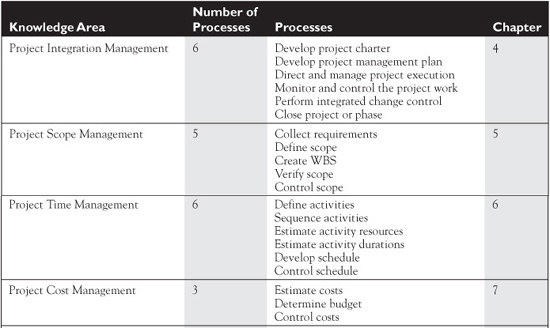

Magic PMP Formulas
The following shows the major formulas you should know for the exam.
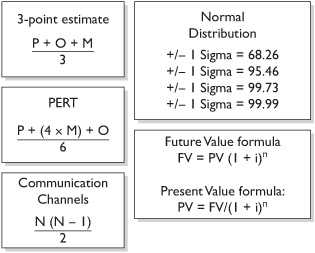
Earned Value Management Formulas
Table B-2 shows the EVM formulas you should know for the exam.
TABLE B-2 Project Management Earned Value Management Formulas
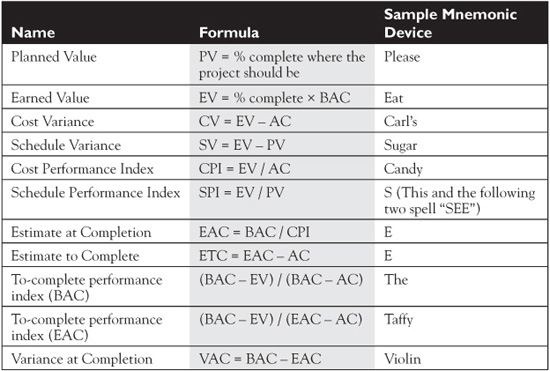
Quick PMP Facts
This section has some quick facts you should know at a glance. Hold on, this moves pretty fast.
Organizational Structures
Organizational structures are relevant to the project manager’s authority. A project manager has authority from weakest to highest in the following order:
![]() Functional
Functional
![]() Weak matrix
Weak matrix
![]() Balanced matrix
Balanced matrix
![]() Strong matrix
Strong matrix
![]() Projectized
Projectized
WBS Facts
The work breakdown structure is the big picture of the project deliverables: It is not the activities that will create the project, but the components the project will create. The WBS helps the project team and the project manager create accurate cost and time estimates. The WBS also helps the project team and the project manager create an accurate activity list. The WBS is an input to five planning processes.
![]() Cost estimating
Cost estimating
![]() Cost budgeting
Cost budgeting
![]() Resource planning
Resource planning
![]() Risk management planning
Risk management planning
![]() Activity definition
Activity definition
Project Scope Facts
Projects are temporary endeavors to create a unique product. They are selected by one of two methods.
![]() Benefit measurement methods These include scoring models, cost-benefit ratios, and economic models.
Benefit measurement methods These include scoring models, cost-benefit ratios, and economic models.
![]() Constrained optimization These include mathematical models based on linear, integer, and dynamic programming. (This probably won’t be on the PMP exam as a viable answer.)
Constrained optimization These include mathematical models based on linear, integer, and dynamic programming. (This probably won’t be on the PMP exam as a viable answer.)
The project scope defines all of the required work, and only the required work, to complete the project. Scope management is the process of ensuring that the project work is within scope and protecting the project from scope creep. The scope statement, along with the WBS and WBS dictionary, is the baseline for all future project decisions. There are two types of scope.
![]() Product scope Defines the attributes of the product or service the project is creating
Product scope Defines the attributes of the product or service the project is creating
![]() Project scope Defines the required work of the project to create the product
Project scope Defines the required work of the project to create the product
Scope verification is the process completed at the end of each phase and of each project to confirm that the project has met the requirements. It leads to formal acceptance of the project deliverable.
Project Time Facts
Time can be a project constraint. Effective time management is the scheduling and sequencing of activities in the best order to ensure that the project completes successfully and in a reasonable amount of time. These are some key terms for time management.
![]() Lag Waiting between activities
Lag Waiting between activities
![]() Lead Activities come closer together and even overlap
Lead Activities come closer together and even overlap
![]() Free float The amount of time an activity can be delayed without delaying the next scheduled activity’s start date
Free float The amount of time an activity can be delayed without delaying the next scheduled activity’s start date
![]() Total float The amount of time an activity can be delayed without delaying the project’s finish date
Total float The amount of time an activity can be delayed without delaying the project’s finish date
![]() Float Sometimes called slack—a perfectly acceptable synonym
Float Sometimes called slack—a perfectly acceptable synonym
![]() Duration May be abbreviated as “du.” For example, du = 8d means the duration is eight days.
Duration May be abbreviated as “du.” For example, du = 8d means the duration is eight days.
There are three types of dependencies between activities.
![]() Mandatory This hard logic requires a specific sequence between activities.
Mandatory This hard logic requires a specific sequence between activities.
![]() Discretionary This soft logic prefers a sequence between activities.
Discretionary This soft logic prefers a sequence between activities.
![]() External Due to conditions outside of the project, such as those created by vendors, the sequence must happen in a given order.
External Due to conditions outside of the project, such as those created by vendors, the sequence must happen in a given order.
Project Cost Facts
There are several methods of providing project estimates.
![]() Bottom-up Project costs start at zero, each component in the WBS is estimated for costs, and then the “grand total” is calculated. This is the longest method to complete, but provides the most accurate estimate.
Bottom-up Project costs start at zero, each component in the WBS is estimated for costs, and then the “grand total” is calculated. This is the longest method to complete, but provides the most accurate estimate.
![]() Analogous Project costs are based on a similar project. This is a form of expert judgment, but it is also a top-down estimating approach, so it is less accurate than a bottom-up estimate.
Analogous Project costs are based on a similar project. This is a form of expert judgment, but it is also a top-down estimating approach, so it is less accurate than a bottom-up estimate.
![]() Parametric Modeling Price is based on cost per unit; examples include cost per metric ton, cost per yard, and cost per hour.
Parametric Modeling Price is based on cost per unit; examples include cost per metric ton, cost per yard, and cost per hour.
There are four types of costs attributed to a project.
![]() Variable costs The costs are dependent on other variables. For example, the cost of a food-catered event depends on how many people register to attend the event.
Variable costs The costs are dependent on other variables. For example, the cost of a food-catered event depends on how many people register to attend the event.
![]() Fixed costs The cost remains constant throughout the project. For example, a rented piece of equipment has the same fee each month, even if it is used more in some months than in others.
Fixed costs The cost remains constant throughout the project. For example, a rented piece of equipment has the same fee each month, even if it is used more in some months than in others.
![]() Direct costs The cost is directly attributed to an individual project and cannot be shared with other projects (for example, airfare to attend project meetings, hotel expenses, and leased equipment that is used only on the current project).
Direct costs The cost is directly attributed to an individual project and cannot be shared with other projects (for example, airfare to attend project meetings, hotel expenses, and leased equipment that is used only on the current project).
![]() Indirect costs These are the costs of doing business; examples include rent, phone, and utilities.
Indirect costs These are the costs of doing business; examples include rent, phone, and utilities.
Quality Management Facts
The cost of quality is the money spent investing in training, in meeting requirements for safety and other laws and regulations, and in taking steps to ensure quality acceptance. The cost of nonconformance is the cost associated with rework, downtime, lost sales, and waste of materials.
Some common quality management charts and methods include the following:
![]() Ishikawa diagrams (also called fishbone diagrams) are used to find causes and effects that contribute to a problem.
Ishikawa diagrams (also called fishbone diagrams) are used to find causes and effects that contribute to a problem.
![]() Flow charts show the relationship between components and the flow of a process through a system.
Flow charts show the relationship between components and the flow of a process through a system.
![]() Pareto diagrams identify project problems and their frequencies. These are based on the 80/20 rule: 80 percent of project problems stem from 20 percent of the work.
Pareto diagrams identify project problems and their frequencies. These are based on the 80/20 rule: 80 percent of project problems stem from 20 percent of the work.
![]() Control charts plot out the result of samplings to determine if projects are “in control” or “out of control.”
Control charts plot out the result of samplings to determine if projects are “in control” or “out of control.”
![]() Kaizen technologies comprise approaches to make small improvements in an effort to reduce costs and achieve consistency.
Kaizen technologies comprise approaches to make small improvements in an effort to reduce costs and achieve consistency.
![]() Just-in-time ordering reduces the cost of inventory, but requires additional quality because materials would not be readily available if mistakes occur.
Just-in-time ordering reduces the cost of inventory, but requires additional quality because materials would not be readily available if mistakes occur.
Human Resource Facts
There are several human resource theories the PMP candidate should be familiar with on the PMP exam. They are the following:
![]() Maslow’s Hierarchy of Needs There are five layers of needs for all humans: physiological, safety, social (such as love and friendship), self-esteem, and the crowning jewel, self-actualization.
Maslow’s Hierarchy of Needs There are five layers of needs for all humans: physiological, safety, social (such as love and friendship), self-esteem, and the crowning jewel, self-actualization.
![]() McClelland’s Theory of Needs Needs are developed by the person’s life experiences, and may shift over time. Of the three needs that drive people—power, affiliation, and achievement—one of these is the most prominent. McClelland developed the Thematic Apperception Test to determine what needs are driving individuals.
McClelland’s Theory of Needs Needs are developed by the person’s life experiences, and may shift over time. Of the three needs that drive people—power, affiliation, and achievement—one of these is the most prominent. McClelland developed the Thematic Apperception Test to determine what needs are driving individuals.
![]() Herzberg’s Theory of Motivation There are two catalysts for workers: hygiene agents and motivating agents.
Herzberg’s Theory of Motivation There are two catalysts for workers: hygiene agents and motivating agents.
![]() Hygiene agents These do nothing to motivate, but their absence demo-tivates workers. Hygiene agents are the expectations all workers have: job security, a paycheck, clean and safe working conditions, a sense of belonging, civil working relationships, and other basic attributes associated with employment.
Hygiene agents These do nothing to motivate, but their absence demo-tivates workers. Hygiene agents are the expectations all workers have: job security, a paycheck, clean and safe working conditions, a sense of belonging, civil working relationships, and other basic attributes associated with employment.
![]() Motivating agents These are the elements that motivate people to excel. They include responsibility, appreciation of work, recognition, opportunity to excel, education, and other opportunities associated with work other than just financial rewards.
Motivating agents These are the elements that motivate people to excel. They include responsibility, appreciation of work, recognition, opportunity to excel, education, and other opportunities associated with work other than just financial rewards.
![]() McGregor’s Theory of X and Y This theory states that “X” people are lazy, don’t want to work, and need to be micromanaged and that “Y” people are self-led, motivated, and can accomplish things on their own.
McGregor’s Theory of X and Y This theory states that “X” people are lazy, don’t want to work, and need to be micromanaged and that “Y” people are self-led, motivated, and can accomplish things on their own.
![]() Ouchi’s Theory Z This theory holds that workers are motivated by a sense of commitment, opportunity, and advancement. Workers will work if they are challenged and motivated. Think participative management.
Ouchi’s Theory Z This theory holds that workers are motivated by a sense of commitment, opportunity, and advancement. Workers will work if they are challenged and motivated. Think participative management.
![]() Expectancy Theory People will behave based on what they expect as a result of their behavior. In other words, people will work in relation to the expected reward of the work.
Expectancy Theory People will behave based on what they expect as a result of their behavior. In other words, people will work in relation to the expected reward of the work.
Communication Facts
Communicating is the most important skill for the project manager. With that in mind, here are some key facts on communication:
![]() Communication channels formula: N(N − 1)/2. N represents the number of stakeholders. For example, if you have 10 stakeholders, the formula would read 10(10 − 1)/2 for 45 communication channels. Pay special attention to questions wanting to know how many additional communication channels you have based on added stakeholders. For example, if you have 25 stakeholders on your project and have recently added 5 team members, how many additional communication channels do you now have? You’ll have to calculate the original number of communication channels, 25(25 − 1)/2 = 300; then calculate the new number with the added team members, 30(30 − 1)/2 = 435; and finally, subtract the difference between the two: 435 − 300 = 135, the number of additional communication channels.
Communication channels formula: N(N − 1)/2. N represents the number of stakeholders. For example, if you have 10 stakeholders, the formula would read 10(10 − 1)/2 for 45 communication channels. Pay special attention to questions wanting to know how many additional communication channels you have based on added stakeholders. For example, if you have 25 stakeholders on your project and have recently added 5 team members, how many additional communication channels do you now have? You’ll have to calculate the original number of communication channels, 25(25 − 1)/2 = 300; then calculate the new number with the added team members, 30(30 − 1)/2 = 435; and finally, subtract the difference between the two: 435 − 300 = 135, the number of additional communication channels.
![]() Fifty-five percent of communication is nonverbal.
Fifty-five percent of communication is nonverbal.
![]() Effective listening is the ability to watch the speaker’s body language, interpret paralingual clues, and decipher facial expressions. Following the message, effective listening has the listener asking questions to achieve clarity and offering feedback.
Effective listening is the ability to watch the speaker’s body language, interpret paralingual clues, and decipher facial expressions. Following the message, effective listening has the listener asking questions to achieve clarity and offering feedback.
![]() Active listening requires receivers of the message to offer clues, such as nodding to indicate they are listening. It also requires receivers to repeat the message, ask questions, and continue the discussion if clarification is needed.
Active listening requires receivers of the message to offer clues, such as nodding to indicate they are listening. It also requires receivers to repeat the message, ask questions, and continue the discussion if clarification is needed.
![]() Communication can be hindered by trendy phrases, jargon, and extremely pessimistic comments. In addition, other communication barriers include noise, hostility, cultural differences, and technical interruptions.
Communication can be hindered by trendy phrases, jargon, and extremely pessimistic comments. In addition, other communication barriers include noise, hostility, cultural differences, and technical interruptions.
Risk Management Facts
Risks are unplanned events that can have positive or negative effects on the projects. Most risks are seen as threats to the project’s success—but not all risks are bad. For example, there is a 20 percent probability that the project will realize a discount in shipping, which will save the project $15,000. If this risk happens, the project will save money; if the risk doesn’t happen, the project will have to spend the $15,000. Risks should be identified as early as possible in the planning process. A person’s willingness to accept risk is the utility function (also called the utility theory). The Delphi Technique can be used to build consensus on project risks.
The only output of risk planning is the risk management plan. There are two broad types of risks.
![]() Business risk The loss of time and finances (where a downside and upside exist)
Business risk The loss of time and finances (where a downside and upside exist)
![]() Pure risk The loss of life, injury, and theft (where only a downside exists)
Pure risk The loss of life, injury, and theft (where only a downside exists)
Risks can be responded to in one of seven methods.
![]() Avoidance Avoid the risk by planning a different technique to remove the risk from the project.
Avoidance Avoid the risk by planning a different technique to remove the risk from the project.
![]() Mitigation Reduce the probability or impact of the risk.
Mitigation Reduce the probability or impact of the risk.
![]() Acceptance The risk’s probability or impact may be small enough that the risk can be accepted.
Acceptance The risk’s probability or impact may be small enough that the risk can be accepted.
![]() Transference The risk is not eliminated, but the responsibility and ownership of the risk is transferred to another party (for example, through insurance).
Transference The risk is not eliminated, but the responsibility and ownership of the risk is transferred to another party (for example, through insurance).
![]() Exploit The organization wants to ensure that the identified risk does happen to realize the positive impact associated with the risk event.
Exploit The organization wants to ensure that the identified risk does happen to realize the positive impact associated with the risk event.
![]() Share Sharing is nice. When sharing, the risk ownership is transferred to the organization that can most capitalize on the risk opportunity.
Share Sharing is nice. When sharing, the risk ownership is transferred to the organization that can most capitalize on the risk opportunity.
![]() Enhance To enhance a risk is to attempt to modify its probability and/or its impacts to realize the most gains from the identified risk.
Enhance To enhance a risk is to attempt to modify its probability and/or its impacts to realize the most gains from the identified risk.
Risk management also includes the monitoring and controlling of risk characteristics, new risks, and the results of risk responses. Terms that are unique to risk management are:
![]() Contingency funds Monies reserved for risk events.
Contingency funds Monies reserved for risk events.
![]() Secondary risks A risk that comes into a project as a direct result of another risk response.
Secondary risks A risk that comes into a project as a direct result of another risk response.
![]() Risk triggers A condition, event, or warning signs of a risk event that causes a risk reaction.
Risk triggers A condition, event, or warning signs of a risk event that causes a risk reaction.
![]() Residual risks Risks that remain after a risk response. These are usually small and are accepted by the project team.
Residual risks Risks that remain after a risk response. These are usually small and are accepted by the project team.
Procurement Facts
A contract statement of work (SOW) is provided to the potential sellers so they can create accurate bids, quotes, and proposals for the buyer. A bidders’ conference may be held so sellers can query the buyer on the product or service to be procured.
A contract is a formal agreement, preferably written, between a buyer and a seller. On the PMP exam, procurement questions are usually from the buyer’s point of view. All requirements the seller is to complete should be clearly written in the contract. Requirements of both parties must be met, or legal proceedings may follow. Table B-3 sums up all the contract types you should know for your exam.
TABLE B-3 Project Management Contract Types
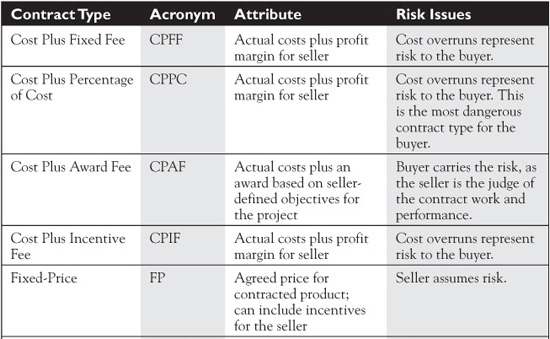
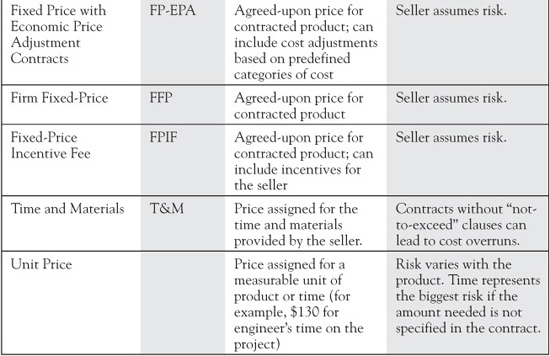
You should also know that a purchase order is a unilateral form of contract and that a letter of intent is not a contract, but shows the intent of the buyer to purchase from a specific seller.
